 
|
 
|
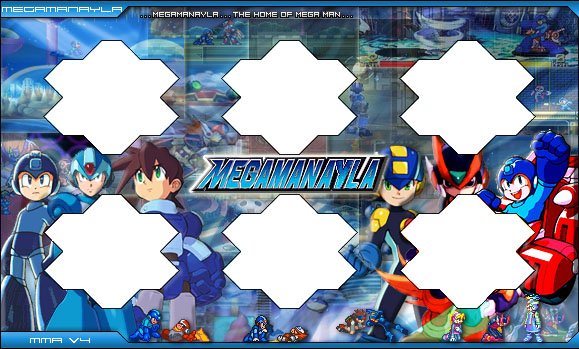
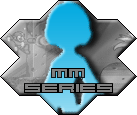
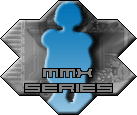
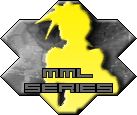
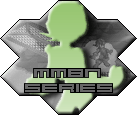
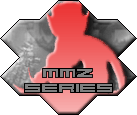
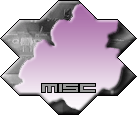
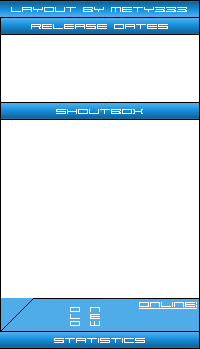





|
This file is about The History of Mega Man. It summarizes what happened so far in the Mega Man universe and tells about the evolution of Mega Man. |
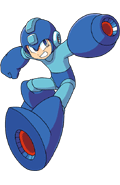 We'll
begin at the beginning, with the original
Mega Man himself, known as Rockman in
Japan, since MM's real name is "Rock". Created by Dr. Light as a lab assistant,
Rock and his sister, Roll, lived in peace in the year 20XX AD. That is, until
Dr. Light's former partner, Dr. Wily, decided to reprogram 6 other robots and
try to take over the world. And so, the "Blue Bomber" first appeared on US
shores in 1987, with the absolute worst box art known to man. However, the game
itself was unparalleled; classic platform design, but the ability to beat the
crap out of a boss, then steal their powers for your own? That was a radical
idea back then. With the release of
Mega Man 2, however, gamers were in for a
real treat. Not only were there 8 bosses now (rather than a measly 6), but
Capcom added a password system, 3 special items, the ever popular E-tanks (to
completely refill your life), and more. MM2 tops the favorite list for many Mega
Man fans, with good reason.
We'll
begin at the beginning, with the original
Mega Man himself, known as Rockman in
Japan, since MM's real name is "Rock". Created by Dr. Light as a lab assistant,
Rock and his sister, Roll, lived in peace in the year 20XX AD. That is, until
Dr. Light's former partner, Dr. Wily, decided to reprogram 6 other robots and
try to take over the world. And so, the "Blue Bomber" first appeared on US
shores in 1987, with the absolute worst box art known to man. However, the game
itself was unparalleled; classic platform design, but the ability to beat the
crap out of a boss, then steal their powers for your own? That was a radical
idea back then. With the release of
Mega Man 2, however, gamers were in for a
real treat. Not only were there 8 bosses now (rather than a measly 6), but
Capcom added a password system, 3 special items, the ever popular E-tanks (to
completely refill your life), and more. MM2 tops the favorite list for many Mega
Man fans, with good reason.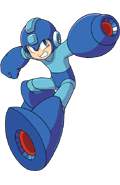 So
that was the 8-bit era. Mega Man broke into the 16-bit age with
Mega Man 7 on
the SNES. Aside from the later levels being notoriously tough, this game
introduced 3 new characters to the MM universe: Auto, Bass, and Treble, all of
whom would become fan favorites later on (especially Bass). Auto came in
especially handy, as he'd sell you all manner of handy upgrades. We also got
Mega Man Soccer, an abomination if there ever was one. Poor design, and the game
itself seemed unfinished, due to numerous glitches! Much later, US audiences got
Mega Man & Bass for the Game Boy Advance, a port of the Japan-only
Rockman &
Forte title that appeared on the Super Famicom (SNES). Any MM fan will tell you
that the original version is far superior; the GBA port was cropped far too
much, and much of the gameplay suffers as a result. That was about it for the
original series; during the 16-bit age, a different Mega Man series was in the
spotlight. We'll get to that in a bit.
So
that was the 8-bit era. Mega Man broke into the 16-bit age with
Mega Man 7 on
the SNES. Aside from the later levels being notoriously tough, this game
introduced 3 new characters to the MM universe: Auto, Bass, and Treble, all of
whom would become fan favorites later on (especially Bass). Auto came in
especially handy, as he'd sell you all manner of handy upgrades. We also got
Mega Man Soccer, an abomination if there ever was one. Poor design, and the game
itself seemed unfinished, due to numerous glitches! Much later, US audiences got
Mega Man & Bass for the Game Boy Advance, a port of the Japan-only
Rockman &
Forte title that appeared on the Super Famicom (SNES). Any MM fan will tell you
that the original version is far superior; the GBA port was cropped far too
much, and much of the gameplay suffers as a result. That was about it for the
original series; during the 16-bit age, a different Mega Man series was in the
spotlight. We'll get to that in a bit.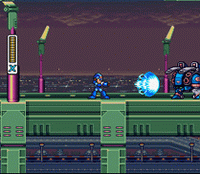 With
the introduction of the Super NES, many gamers wondered what would become of our
hero Mega Man. Aside from the original MM appearing in
Mega Man 7, fans got a real surprise with the release of
Mega Man X. At first, many were confused; a) they thought this was a later version of the original MM, and b) they thought the "X" was the Roman numeral "ten." Well, neither is true.
With
the introduction of the Super NES, many gamers wondered what would become of our
hero Mega Man. Aside from the original MM appearing in
Mega Man 7, fans got a real surprise with the release of
Mega Man X. At first, many were confused; a) they thought this was a later version of the original MM, and b) they thought the "X" was the Roman numeral "ten." Well, neither is true.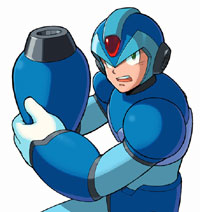 X returned to the Saturn and Playstation for another game,
Mega Man X4, where Zero was a full playable character. In fact, to get the whole story, you had to play through the game twice; once with X, and once with Zero. With two playable characters to choose from, you also got multiple endings. This game revealed more of Zero's backstory, and we discover that he was indeed the final creation of one Dr. Wily! Zero himself was handled quite well as a playable character; rather than earning special weapons like X did, Zero would earn special moves instead (i.e., rather than shooting fireballs, Zero would do a jumping flame slash with his beam saber. We also had some new characters thrown into the mix, like the General, the Colonel, Double, and a love interest for Zero named Iris.
X returned to the Saturn and Playstation for another game,
Mega Man X4, where Zero was a full playable character. In fact, to get the whole story, you had to play through the game twice; once with X, and once with Zero. With two playable characters to choose from, you also got multiple endings. This game revealed more of Zero's backstory, and we discover that he was indeed the final creation of one Dr. Wily! Zero himself was handled quite well as a playable character; rather than earning special weapons like X did, Zero would earn special moves instead (i.e., rather than shooting fireballs, Zero would do a jumping flame slash with his beam saber. We also had some new characters thrown into the mix, like the General, the Colonel, Double, and a love interest for Zero named Iris.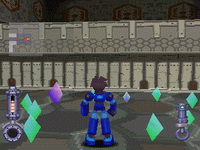 In
1998, the Playstation was at large, and Capcom decided to expand the Mega Man
franchise yet again. Rather than a direct continuation of the storyline (as the
Mega Man X series officially takes place at least 100 years after the original
Mega Man games), Capcom created an "alternate" timeline where the Earth was
almost completely covered by water, and people eked out an existence on the
various islands. We're never told exactly what year it is, but I'll speculate
more on that later.
In
1998, the Playstation was at large, and Capcom decided to expand the Mega Man
franchise yet again. Rather than a direct continuation of the storyline (as the
Mega Man X series officially takes place at least 100 years after the original
Mega Man games), Capcom created an "alternate" timeline where the Earth was
almost completely covered by water, and people eked out an existence on the
various islands. We're never told exactly what year it is, but I'll speculate
more on that later.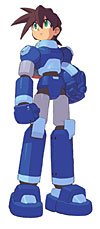 And learn more we did.
Mega Man Legends 2 expanded very
heavily upon the original story, and over the course of the game, revealed just
about everything about MM himself, as well as the new characters (Sera and Yuna),
his creator (the Master), and the ancient civilization. Mega Man Trigger was a
Purifier unit himself (essentially a glorified guard robot) on a manmade
satellite world called "Elysium." He was charged with protecting the Master (a
perfect being, most likely human) and the System (the network that controlled
everything on Elysium and Terra [Earth]). The Master helped create "carbon
units" (humans) to populate the Earth, and for a time, he lived among them. As
his life was finally coming to an end, he instructed Mega Man to destroy the
System and let humans control their own destiny. He succeeded, but at a cost;
Sera, a "Mother" unit in charge of the System on Elysium, attacked him on Terra.
They sustained significant damage, so Yuna (the Mother unit in charge of Terra)
reverted Mega Man to a protoform state (a baby), and sealed him away in some ruins on
Nino Island. He was found by Barrell Casket, who adopted him. MM also completely
lost his memory. Sera ended up sealed away on the Forbidden Island (the same
place where Roll's parents were lost). She's freed at the beginning of
Legends
2, and she planned to reinitialize the entire planet and restore the Master's
civilization. Naturally, this brings her into conflict with MM yet again. Yuna
shows up, too, but in the guise of Roll's long-lost mother! MM's heavily damaged
in a battle with Sera's assistant Geetz, but his pal Data rebuilds his memory. As
it turns out, Data was originally created as a memory backup unit for MM, which
explains why he knows so much about MM's past (and how he was able to shut down
the reinitialization program in the
first Legends game). Assisted by Yuna (the
Mother of the System on Earth), MM finally defeats Sera and restores order...but
he ends up stuck on Elysium. Sera is reawakened in Yuna's original body; if she
died, the System would automatically reset and reinitialize the planet anyway.
Back on Earth, Roll and Tron Bonne join forces to build a ship to bring MM
back...if only they could stop arguing!
And learn more we did.
Mega Man Legends 2 expanded very
heavily upon the original story, and over the course of the game, revealed just
about everything about MM himself, as well as the new characters (Sera and Yuna),
his creator (the Master), and the ancient civilization. Mega Man Trigger was a
Purifier unit himself (essentially a glorified guard robot) on a manmade
satellite world called "Elysium." He was charged with protecting the Master (a
perfect being, most likely human) and the System (the network that controlled
everything on Elysium and Terra [Earth]). The Master helped create "carbon
units" (humans) to populate the Earth, and for a time, he lived among them. As
his life was finally coming to an end, he instructed Mega Man to destroy the
System and let humans control their own destiny. He succeeded, but at a cost;
Sera, a "Mother" unit in charge of the System on Elysium, attacked him on Terra.
They sustained significant damage, so Yuna (the Mother unit in charge of Terra)
reverted Mega Man to a protoform state (a baby), and sealed him away in some ruins on
Nino Island. He was found by Barrell Casket, who adopted him. MM also completely
lost his memory. Sera ended up sealed away on the Forbidden Island (the same
place where Roll's parents were lost). She's freed at the beginning of
Legends
2, and she planned to reinitialize the entire planet and restore the Master's
civilization. Naturally, this brings her into conflict with MM yet again. Yuna
shows up, too, but in the guise of Roll's long-lost mother! MM's heavily damaged
in a battle with Sera's assistant Geetz, but his pal Data rebuilds his memory. As
it turns out, Data was originally created as a memory backup unit for MM, which
explains why he knows so much about MM's past (and how he was able to shut down
the reinitialization program in the
first Legends game). Assisted by Yuna (the
Mother of the System on Earth), MM finally defeats Sera and restores order...but
he ends up stuck on Elysium. Sera is reawakened in Yuna's original body; if she
died, the System would automatically reset and reinitialize the planet anyway.
Back on Earth, Roll and Tron Bonne join forces to build a ship to bring MM
back...if only they could stop arguing!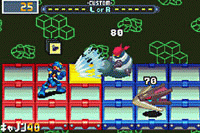 What is this, the Twilight Zone'! No, this is the world of
Mega Man Battle Network, a radical revamp of the Mega Man franchise introduced by Capcom in 2001. Taking place in the year 200X, society is very similar to our own. Robots are few and far between, but people are much more dependent on computers and digital networks. Almost everything has a network port on it; TVs, refrigerators, even traffic lights. Most people carry PETs (PErsonal Terminals), which are combination cellphones/PDAs/computers. Many of these PETs contain AI programs called Navis (Net Navigators). Navis have a variety of purposes: assistants, confidants, gophers, even virus-busters. Enter Lan Hikari, a typical student. His Navi is named Mega Man (MegaMan.EXE, to be accurate), and he was designed by Lan's father, Dr. Hikari. Mega Man seems weak at first, but he soon learns the art of virus-busting and unleashes his hidden potential.
What is this, the Twilight Zone'! No, this is the world of
Mega Man Battle Network, a radical revamp of the Mega Man franchise introduced by Capcom in 2001. Taking place in the year 200X, society is very similar to our own. Robots are few and far between, but people are much more dependent on computers and digital networks. Almost everything has a network port on it; TVs, refrigerators, even traffic lights. Most people carry PETs (PErsonal Terminals), which are combination cellphones/PDAs/computers. Many of these PETs contain AI programs called Navis (Net Navigators). Navis have a variety of purposes: assistants, confidants, gophers, even virus-busters. Enter Lan Hikari, a typical student. His Navi is named Mega Man (MegaMan.EXE, to be accurate), and he was designed by Lan's father, Dr. Hikari. Mega Man seems weak at first, but he soon learns the art of virus-busting and unleashes his hidden potential.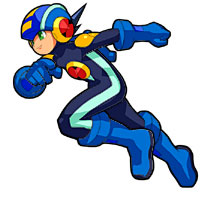 While the
MMBN universe began on the GBA, it's since expanded a bit. One game's been released for the Gamecube:
Mega Man Network Transmission. Unlike the GBA titles, this game's a platformer, very reminiscent of the original NES
Mega Man games. In fact,
MMNT is loaded with homages to the
classic series, like sections of levels that are perfect reproductions of NES levels. Quick Man's level even has those godforsaken laser beams from
Mega Man 2! Anyway, this game takes place between
MMBN and
MMBN2, and features a few new bosses, like Needle Man, Gravity Man, Sword Man, Star Man, and Bright Man. There's also a new Navi known as "Zero"...
While the
MMBN universe began on the GBA, it's since expanded a bit. One game's been released for the Gamecube:
Mega Man Network Transmission. Unlike the GBA titles, this game's a platformer, very reminiscent of the original NES
Mega Man games. In fact,
MMNT is loaded with homages to the
classic series, like sections of levels that are perfect reproductions of NES levels. Quick Man's level even has those godforsaken laser beams from
Mega Man 2! Anyway, this game takes place between
MMBN and
MMBN2, and features a few new bosses, like Needle Man, Gravity Man, Sword Man, Star Man, and Bright Man. There's also a new Navi known as "Zero"...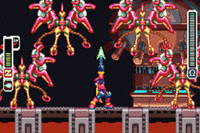 Over
100 years after the Mega Man X series, Reploids fear for their lives, as the Neo Arcadian government is hunting them down and executing them. Their reasoning? You can't have Reploids going Maverick if there are no Reploids to begin with! There's a small Resistance movement trying to survive, but it's not going well. Led by a human, Ciel, the Resistance is getting the crap kicked out of it by Neo Arcadian forces when they stumble upon the legendary hero: Zero.
Over
100 years after the Mega Man X series, Reploids fear for their lives, as the Neo Arcadian government is hunting them down and executing them. Their reasoning? You can't have Reploids going Maverick if there are no Reploids to begin with! There's a small Resistance movement trying to survive, but it's not going well. Led by a human, Ciel, the Resistance is getting the crap kicked out of it by Neo Arcadian forces when they stumble upon the legendary hero: Zero.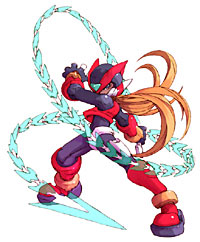 Then there's the matter of Cyber Elves. These little data programs are found floating around in levels, or you can get them by dispatching certain enemies. You can equip up to three of them at any given time, but once you use one, it's gone forever (with some exceptions; we'll get to that in a moment). The Elves have various effects, like destroying all minor enemies on the screen, providing cover fire, etc. The best ones, however, are the ones you need to "raise." This is accomplished by feeding them Energy Crystals (found everywhere; they're the equivalent of currency). Once Elves are raised, then they're ready for use, and they almost always have a permanent effect. Some will extend your lifebar, others will increase your speed or defense, and still others will turn into much-needed Sub Tanks.
Then there's the matter of Cyber Elves. These little data programs are found floating around in levels, or you can get them by dispatching certain enemies. You can equip up to three of them at any given time, but once you use one, it's gone forever (with some exceptions; we'll get to that in a moment). The Elves have various effects, like destroying all minor enemies on the screen, providing cover fire, etc. The best ones, however, are the ones you need to "raise." This is accomplished by feeding them Energy Crystals (found everywhere; they're the equivalent of currency). Once Elves are raised, then they're ready for use, and they almost always have a permanent effect. Some will extend your lifebar, others will increase your speed or defense, and still others will turn into much-needed Sub Tanks.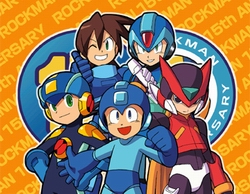 So
where does Mega Man fit into the grand scheme of things? In a world of mindless
FPS clones, GTA clones, and other assorted drivel, it's nice to know there's still some quality gaming to be had. He's had his stumbling blocks, but Mega Man rarely lets us down. He's got a rabid fanbase in the US, albeit some are sick fucks who make Mega Man fanzine-porn. I'm not kidding. The worst are the lifeless fangirls who for some odd reason have made Mega Man X and Zero "gay." The whole concept is ludicrous in and of itself: gays are homosexual, right? Robots can't be homosexual, since they're not any type of sexual to begin with! You need to be biological in nature, not mechanical. Sheesh. Apparently, the whole gay video game character thing is much more far-reaching (with Cloud and Sephiroth from Final Fantasy VII being a popular "couple" in that regard), but come on, these are just robots. Leave the mythos alone, and get a life.
So
where does Mega Man fit into the grand scheme of things? In a world of mindless
FPS clones, GTA clones, and other assorted drivel, it's nice to know there's still some quality gaming to be had. He's had his stumbling blocks, but Mega Man rarely lets us down. He's got a rabid fanbase in the US, albeit some are sick fucks who make Mega Man fanzine-porn. I'm not kidding. The worst are the lifeless fangirls who for some odd reason have made Mega Man X and Zero "gay." The whole concept is ludicrous in and of itself: gays are homosexual, right? Robots can't be homosexual, since they're not any type of sexual to begin with! You need to be biological in nature, not mechanical. Sheesh. Apparently, the whole gay video game character thing is much more far-reaching (with Cloud and Sephiroth from Final Fantasy VII being a popular "couple" in that regard), but come on, these are just robots. Leave the mythos alone, and get a life.